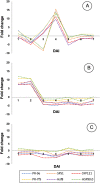Comparative analysis of salicylic acid levels and gene expression in resistant, tolerant, and susceptible cassava varieties following whitefly-mediated SLCMV infection
- PMID: 37604906
- PMCID: PMC10442324
- DOI: 10.1038/s41598-023-40874-3
Comparative analysis of salicylic acid levels and gene expression in resistant, tolerant, and susceptible cassava varieties following whitefly-mediated SLCMV infection
Abstract
Sri Lankan cassava mosaic virus (SLCMV), the primary pathogen responsible for cassava mosaic disease in cassava plantations, is transmitted via infected cutting stems and the whitefly vector, Bemisia tabaci. To obtain better insights into the defense mechanism of cassava against SLCMV, whiteflies were used to induce SLCMV infection for activating the salicylic acid (SA) signaling pathway, which triggers the innate immune system. The study aimed to investigate the specific interactions between viruliferous whiteflies and SA accumulation in resistant (C33), tolerant (Kasetsart 50; KU50), and susceptible (Rayong 11) cassava cultivars by infecting with SLCMV. Leaf samples were collected at various time points, from 1 to 7 days after inoculation (dai). The SA levels were quantified by gas chromatography-mass spectrometry and validated by quantitative reverse transcription polymerase chain reaction. The SA levels increased in KU50 and C33 plants at 2 and 3 dai, respectively, but remained undetected in Rayong11 plants. The expression of PR-9e, PR-7f5, SPS1, SYP121, Hsf8, and HSP90 increased in infected C33 plants at 4 dai, whereas that of KU50 plants decreased immediately at 2 dai, and that of Rayong11 plants increased at 1 dai but gradually decreased thereafter. These findings strongly indicate that SA plays a crucial role in regulating antiviral defense mechanisms, especially in SLCMV-resistant plants. Altogether, the findings provide valuable insights into the mechanisms underlying the activation of SA-mediated anti-SLCMV defense pathways, and the resistance, tolerance, and susceptibility of cassava, which can aid future breeding programs aimed at enhancing SLCMV resistance.
© 2023. Springer Nature Limited.
Conflict of interest statement
The authors declare no competing interests.
Figures



Similar articles
-
Metabolic profiles of Sri Lankan cassava mosaic virus-infected and healthy cassava (Manihot esculenta Crantz) cultivars with tolerance and susceptibility phenotypes.BMC Plant Biol. 2023 Apr 5;23(1):178. doi: 10.1186/s12870-023-04181-3. BMC Plant Biol. 2023. PMID: 37020181 Free PMC article.
-
Analysis of proteomic changes in cassava cv. Kasetsart 50 caused by Sri Lankan cassava mosaic virus infection.BMC Plant Biol. 2022 Dec 10;22(1):573. doi: 10.1186/s12870-022-03967-1. BMC Plant Biol. 2022. PMID: 36494781 Free PMC article.
-
Survey and molecular detection of Sri Lankan cassava mosaic virus in Thailand.PLoS One. 2021 Oct 11;16(10):e0252846. doi: 10.1371/journal.pone.0252846. eCollection 2021. PLoS One. 2021. PMID: 34634034 Free PMC article.
-
Modulation of Plant Interactions with Whitefly and Whitefly-Borne Viruses by Salicylic Acid Signaling Pathway: A Review.Viruses. 2025 Jun 7;17(6):825. doi: 10.3390/v17060825. Viruses. 2025. PMID: 40573416 Free PMC article. Review.
-
Antiretrovirals for reducing the risk of mother-to-child transmission of HIV infection.Cochrane Database Syst Rev. 2007 Jan 24;(1):CD003510. doi: 10.1002/14651858.CD003510.pub2. Cochrane Database Syst Rev. 2007. Update in: Cochrane Database Syst Rev. 2011 Jul 06;(7):CD003510. doi: 10.1002/14651858.CD003510.pub3. PMID: 17253490 Updated.
Cited by
-
Roles of WRKY Transcription Factors in Response to Sri Lankan Cassava Mosaic Virus Infection in Susceptible and Tolerant Cassava Cultivars.Plants (Basel). 2025 Apr 8;14(8):1159. doi: 10.3390/plants14081159. Plants (Basel). 2025. PMID: 40284047 Free PMC article.
-
Enhancing Plant Resistance to Sri Lankan Cassava Mosaic Virus Using Salicylic Acid.Metabolites. 2025 Apr 10;15(4):261. doi: 10.3390/metabo15040261. Metabolites. 2025. PMID: 40278390 Free PMC article.
-
Perceptual Effects of Walnut Volatiles on the Codling Moth.Insects. 2024 May 30;15(6):402. doi: 10.3390/insects15060402. Insects. 2024. PMID: 38921117 Free PMC article.
-
PhWRKY30 activates salicylic acid biosynthesis to positively regulate antiviral defense response in petunia.Hortic Res. 2025 Jan 15;12(5):uhaf013. doi: 10.1093/hr/uhaf013. eCollection 2025 May. Hortic Res. 2025. PMID: 40190442 Free PMC article.
References
-
- FAO. Save and grow: Cassava—A guide to sustainable production intensification, pp. 23–53.
-
- Balat M, Balat H. Recent trends in global production and utilization of bio-ethanol fuel. App. Energy. 2009;86:2273–2282. doi: 10.1016/j.apenergy.2009.03.015. - DOI
-
- Wang HL, et al. First report of Sri Lankan cassava mosaic virus infecting cassava in Cambodia. Plant Dis. 2016;100:1029–1029. doi: 10.1094/pdis-10-15-1228-pdn. - DOI
-
- Uke A, et al. First report of Sri Lankan Cassava Mosaic Virus infecting cassava in Vietnam. Plant Dis. 2018;102:2669. doi: 10.1094/pdis-05-18-0805-pdn. - DOI
Publication types
MeSH terms
Substances
Supplementary concepts
LinkOut - more resources
Full Text Sources
Research Materials

